Recharge and Infiltration Mechanisms of Soil Water in the Floodplain Revealed by Water-Stable Isotopes in the Upper Yellow River
Abstract
:1. Introduction
2. Materials and Methods
2.1. Study Area
2.2. Sample Collection and Processing
2.3. Data Analysis
2.3.1. Line-Conditioned Excess
2.3.2. Amount-Weighted Precipitation Isotopes
2.3.3. Quantifying Proportions of Dual Flows
2.3.4. One-Way ANOVA Analysis
3. Results
3.1. Stable Isotopic Compositions of Precipitation
3.2. Stable Isotopic Compositions of Soil Water
3.3. Soil Moisture Content
3.4. Lc-Excess of Soil Water
3.5. Quantitative Double Flow Mechanism
4. Discussion
4.1. Comparison of Soil Water Isotope and Soil Water Content
4.2. Determination of Soil Water Source
4.3. Soil Water Transport Mode: Preferential Flow and Piston Flow
4.4. Implications for Environment on Floodplain of the Yellow River
5. Conclusions
Author Contributions
Funding
Institutional Review Board Statement
Informed Consent Statement
Data Availability Statement
Conflicts of Interest
References
- Blum, W.E.H. Functions of soil for society and the environment. Rev. Environ. Sci. Bio/Technol. 2005, 4, 75–79. [Google Scholar] [CrossRef]
- Xu, Y.D.; Wang, J.K.; Gao, X.D.; Zhang, Y.L. Application of hydrogen and oxygen stable isotope techniques on soil water reaearch: A review. J. Soil Water Conserv. 2018, 32, 1–9. (In Chinese) [Google Scholar]
- Yang, Y.G.; Fu, B.J. Soil water migration in the unsaturated zone of semiarid region in China from isotope evidence. Hydrol. Earth Syst. Sci. 2017, 21, 1757–1767. [Google Scholar] [CrossRef] [Green Version]
- Evaristo, J.; McDonnell, J.J. Global analysis of streamflow response to forest management. Nature 2019, 570, 455–461. [Google Scholar] [CrossRef]
- Jin, Y.R.; Lu, K.P.; LI, P.; Wang, Q.; Zhang, T.G.; Liu, Y. Research on soil water movement based on stable isotopes. Acta Pedol. Sin. 2015, 52, 792–801. (In Chinese) [Google Scholar]
- Craig, H. Isotopic variations in meteoric waters. Science 1961, 133, 1702–1703. [Google Scholar] [CrossRef] [PubMed]
- Evaristo, J.; McDonnell, J.J.; Scholl, M.A.; Brujinzeel, L.A.; Chun, K.P. Insights into plant water uptake from xylem-water isotope measurements in two tropical catchments with contrasting moisture conditions. Hydrol. Process. 2016, 30, 3210–3227. [Google Scholar] [CrossRef]
- Stewart, M.K.; Morgenstern, U.; McDonnell, J.J. Truncation of stream residence time: How the use of stable isotopes has skewed our concept of streamwater age and origin. Hydrol. Process. 2010, 24, 1646–1659. [Google Scholar] [CrossRef]
- Gazis, C.; Feng, X.H. A stable isotope study of soil water: Evidence for mixing and preferential flow paths. Geoderma 2004, 119, 97–111. [Google Scholar] [CrossRef]
- Deng, W.P.; Yu, X.X.; Jia, G.D.; Li, Y.J.; Liu, Y.J. An analysis of characteristics of hydrogen and oxygen stable isotopes in Jiufeng Mountain areas of Beijing. Adv. Water Sci. 2013, 24, 642–650. (In Chinese) [Google Scholar]
- Zimmeman, U.; Munnich, K.O.; Roether, W.; Roether, W.; Schubach, K.; Siegel, O. Traces determine movement of soil moisture and evapotrans-piration. Science 1996, 152, 346–347. [Google Scholar] [CrossRef] [PubMed]
- McDonnell, J.J. The two water worlds hypothesis: Ecohydrological separation of water between streams and trees? Wiley Interdiscip. Rev. Water. 2014, 1, 323–329. [Google Scholar] [CrossRef]
- Mathieu, R.; Bariac, T. An isotopic study (2H and 18O) of water movements in clayey soils under a semiaridcli-mate. Water Resour. Res. 1996, 32, 779–789. [Google Scholar]
- Brooks, J.R.; Barnard, H.R.; Coulombe, R.; McDonnell, J.J. Ecohydrologic separation of water between trees and streams in a Mediterranean climate. Nat. Geosci. 2010, 3, 100–104. [Google Scholar] [CrossRef]
- Evaristo, J.; Jasechko, S.; McDonnell, J.J. Global separation of plant transpiration from groundwater and streamflow. Nature 2015, 525, 91–94. [Google Scholar] [CrossRef] [PubMed]
- Sprenger, M.; Leistert, H.; Gimbel, K.; Weiler, M. Illuminating hydrological processes at the soil-vegetation-atmosphere interface with water stable isotopes. Rev. Geophys. 2016, 54, 674–704. [Google Scholar] [CrossRef] [Green Version]
- Brantley, S.L.; McDowell, W.H.; Dietrich, W.E.; White, T.S.; Kumar, P.; Anderson, S.P.; Chorover, J.; Lohse, K.A.; Bales, R.C.; Richter, D.D.; et al. Designing a network of critical zone observatories to explore the living skin of the terrestrial Earth. Earth Surf. Dynam. 2017, 5, 841–860. [Google Scholar] [CrossRef] [Green Version]
- Ma, J.; Song, W.F.; Wu, J.K.; Wang, Z.J.; Zhang, X.J.; Liu, Z.B. Characteristics of hydrogen and oxygen isotopes of precipitation and soil water in woodland in water source area of yuanyang terrace. J. Soil Water Conserv. 2016, 30, 243–248. [Google Scholar]
- Tian, L.D.; Yao, T.D.; Tsujmura, M.; Sun, W.Z. Stable isotope in soil water in the middle of tibetan plateau. Acta Pedol. Sinica. 2002, 39, 289–295. (In Chinese) [Google Scholar]
- Cheng, L.P.; Liu, W.Z. Characteristics of stable isotopes in soil water under several typical land use patterns on Loess Tableland. Chin. J. Appl. Ecol. 2012, 23, 651–658. [Google Scholar]
- Zheng, S.K.; Si, B.C.; Zhang, Z.Q.; Li, M.; Wu, Q.F. Mechanism of rainfall infiltration in apple orchards on Loess Tableland, China. Chin. J. Appl. Ecol. 2017, 28, 2870–2878. [Google Scholar]
- Tan, H.B.; Wen, X.W.; Rao, W.B.; Bradd, J.; Huang, J.Z. Temporal variation of stable isotopes in a precipitation-groundwater system: Implications for determining the mechanism of groundwater recharge in high mountain-hills of the Loess Plateau, China. Hydrol. Process. 2016, 30, 1491–1505. [Google Scholar] [CrossRef] [Green Version]
- Sukhija, B.S.; Reddy, D.V.; Nagabhushanam, P.; Hussain, S. Recharge processes: Piston flow vs. preferential flow in semi-arid aquifers of India. Hydrogeol. J. 2003, 11, 387–395. [Google Scholar] [CrossRef]
- Manna, F.; Walton, K.M.; Cherry, J.A.; Parker, B.L. Mechanisms of recharge in a fractured porous rock aquifer in a semi-arid region. J. Hydrol. 2017, 555, 869–880. [Google Scholar] [CrossRef]
- Tian, R.C.; Chen, H.S.; Song, X.F.; Wang, K.L.; Yang, Q.Q. Characteristics of soil water movement using stable isotopes in red soil hilly region of northwest Hunan. Environ. Sci. 2009, 30, 2747–2754. [Google Scholar]
- Zhang, X.J.; Song, W.F.; Wu, J.K.; Wang, Z.J. Characteristics of hydrogen and oxygen isotopes of soil water in the water source area of Yuangyang terrace. Environ. Sci. 2015, 36, 2102–2108. [Google Scholar]
- Wang, H.; Li, Z.B.; Ma, B.; Ma, J.Y.; Zhang, L.T. Characteristics of hydrogen and oxygen isotopes in different waters of the Loess hilly and Gully region. J. Soil Water Conserv. 2016, 30, 85–90. (In Chinese) [Google Scholar]
- Wu, W.; Jiang, W.J.; Jia, Y.N.; Peng, X.Y.; Duan, S.H.; Liu, J.C.; Wang, Z.X. Temporal and spatial distribution of the soil water δD and δ18O in a typical karst vally: A caes study of Zhongliang Mountain, Chongqing city. Environ. Sci. 2018, 39, 5418–5427. [Google Scholar]
- White, J.C. Water Sources and Ecophysiology of Selected Riparian Species of the Southern Appalachian Mountains. Ph.D. Thesis, Wake Forest University, Winston-Salem, NC, USA, 2015. [Google Scholar]
- Zhang, L.P. A Syudy of the Human-Environment Relationship in Lanzhou Basin Based on Topography. Master’s Thesis, Lanzhou University, Lanzhou, China, 2017. (In Chinese). [Google Scholar]
- Zhang, Y.; Zhang, M.J.; Qu, D.Y.; Duan, W.G.; Wang, J.X.; Su, P.Y.; Guo, R. Water Use Strategies of Dominant Species (Caragana korshinskii and Reaumuria soongorica) in Natural Shrubs Based on Stable Isotopes in the Loess Hill, China. Water 2020, 12, 1923. [Google Scholar] [CrossRef]
- Su, P.Y.; Zhang, M.J.; Qu, D.Y.; Wang, J.X.; Zhang, Y.; Yao, X.Y.; Xiao, H.Y. Contrasting Water Use Strategies of Tamarix ramosissima in Different Habitats in the Northwest of Loess Plateau, China. Water 2020, 12, 2791. [Google Scholar] [CrossRef]
- West, A.G.; Patrickson, S.J.; Ehleringer, J.R. Water extraction times for plant and soil materials used in stable isotope analysis. Rapid Commun. Mass Spectrom. 2006, 20, 1317–1321. [Google Scholar] [CrossRef]
- Meng, X.J.; Wen, X.F.; Zhang, X.Y.; Han, J.Y.; Sun, X.M.; Li, X.B. Potential impacts organic contaminant on δ18O andδD in leaf and xylem water detected by isotope ratio infrared spectroscopy. Chin. J. Eco-Agric. 2012, 20, 1359–1365. (In Chinese) [Google Scholar] [CrossRef]
- Liu, W.R.; Peng, X.h.; Shen, Y.J.; Chen, X.M. Measurements of hydrogen and oxygen isotopes in liquid water by isotope ratio infrared spectroscopy (IRIS) and their spectral contamination corrections. Chin. J. Ecol. 2013, 32, 1181–1186. (In Chinese) [Google Scholar]
- Schultz, N.M.; Griffis, T.J.; Lee, X.; Baker, J.M. 2011 Identification and correction of spectral contamination in 2H/1H and 18O/16O measured in leaf, stem, and soil water. Rapid Commun. Mass Spectrom. 2011, 25, 3360–3368. [Google Scholar] [CrossRef] [PubMed]
- Zhao, L.J.; Xiao, H.L.; Zhou, J.; Wang, L.X.; Cheng, G.D.; Zhou, M.X.; Yin, L.; McCabe, M.F. Detailed assessment of isotope ratio infrared spectroscopy and isotope ratio mass spectrometry for the stable isotope analysis of plant and soil waters. Rapid Commun. Mass Spectrom. 2011, 25, 3071–3082. [Google Scholar] [CrossRef]
- Landwehr, J.M.; Coplen, T.B. Line-Conditioned Excess: A New Method for Characterizing Stable Hydrogen and Oxygen Iso-Tope Ratios in Hydrologic Systems; IAEA: Vienna, Austria, 2006; pp. 132–135. [Google Scholar]
- Sprenger, M.; Tetzlaff, D.; Soulsby, C. Soil water stable isotopes reveal evaporation dynamics at the soil–plant–atmosphere interface of the critical zone. Hydrol. Earth Syst. Sci. 2017, 21, 3839–3858. [Google Scholar] [CrossRef] [Green Version]
- Hasselquist, N.J.; Benegas, L.; Roupsard, O.; Malmer, A.; Ilstedt, U. Canopy cover effects on local soil water dynamics in a tropical agroforestry system: Evaporation drives soil water isotopic enrichment. Hydrol. Process. 2018, 32, 994–1004. [Google Scholar] [CrossRef]
- Sprenger, M.; Tetzlaff, D.; Tunaley, C.; Dick, J.; Soulsby, C. Evaporation fractionation in a peatland drainage network affects stream water isotope composition. Water Resour. Res. 2017, 53, 851–866. [Google Scholar] [CrossRef]
- Dai, J.J.; Zhang, X.P.; Luo, Z.D.; Wang, R.; Liu, F.J.; He, X.G. 2020 Variation of stable isotopes in soil water Cinnamomum Camphora woods in Changsha and its influencing factors. Acta Pedol. Sin. 2020. [Google Scholar] [CrossRef]
- Stock, B.C.; Semmens, B.X. MixSIAR GUI User Manual. Version 2013, 3, 1–42. [Google Scholar] [CrossRef]
- Xiang, W.; Si, B.C.; Biswas, A.; Li, Z. Quantifying dual recharge mechanisms in deep unsaturated zone of Chinese Loess Plateau using stable isotopes. Geoderma 2019, 337, 773–781. [Google Scholar] [CrossRef]
- Xu, Q.; Liu, S.R.; An, S.Q.; Jiang, Y.X.; Lin, G.H. Characteristics of hydrogen stable isotope in soil water of sub_alpine dark coniferous forest in Wolong, Sichuan province. Sci. Silvae Sin. 2007, 1, 8–14. [Google Scholar]
- Hervé-Fernández, P.; Oyarzún, C.; Brumbt, C.; Huygens, D.; Bodé, S.; Verhoest, N.E.C.; Boeckx, P. Assessing the ‘two water worlds’ hypothesis and water sources for native and exotic evergreen species in south-central Chile. Hydrol. Process. 2016, 30, 4227–4241. [Google Scholar] [CrossRef]
- Jasechko, S.; Birks, S.J.; Gleeson, T.; Wada, Y.; Fawcett, P.J.; Sharp, Z.D.; McDonnell, J.J.; Welker, J.M. The pronounced seasonality of global groundwater recharge. Water Resour. Res. 2014, 50, 8845–8867. [Google Scholar] [CrossRef] [Green Version]
- Li, J.; Pang, Z.; Kong, Y.; Wang, S.; Bai, G.; Zhao, H.; Zhou, D.; Sun, F.; Yang, Z. Groundwater isotopes biased toward heavy rainfall events and implications on the local meteoric water line. J. Geophys. Res. Atmospheres. 2018, 123, 6259–6266. [Google Scholar] [CrossRef]
- Xiang, W.; Evaristo, J.; Li, Z. Recharge mechanisms of deep soil water revealed by water isotopes in deep loess deposits. Geoderma 2020. [Google Scholar] [CrossRef]
- Wiekenkamp, I.; Huisman, J.A.; Bogena, H.R.; Lin, H.S.; Vereecken, H. Spatial and temporal occurrence of preferential flow in a forested headwater catchment. J. Hydrol. 2016, 534, 139–149. [Google Scholar] [CrossRef]
- Jin, Z.; Guo, L.; Lin, H.; Wang, Y.; Yu, Y.; Chu, G.; Zhang, J. Soil moisture response to rainfall on the Chinese Loess Plateau after a long-term vegetation rehabilitation. Hydrol. Process. 2018, 32, 1738–1754. [Google Scholar] [CrossRef]
- Beven, K.; Germann, P. Macropores and water flow in soils revisited. Water Resour. Res. 2013, 49, 3071–3092. [Google Scholar] [CrossRef] [Green Version]
- Mali, N.; Urbanc, J. Isotope oxygen-18 as natural tracer of water movement in a coarse gravel unsaturated zone. Water Air Soil Pollut. 2009, 203, 291–303. [Google Scholar] [CrossRef]
- Good, S.P.; Noone, D.; Bowen, G. Hydrologic connectivity constrains partitioning of global terrestrial water fluxes. Science 2015, 349, 175–177. [Google Scholar] [CrossRef] [PubMed] [Green Version]
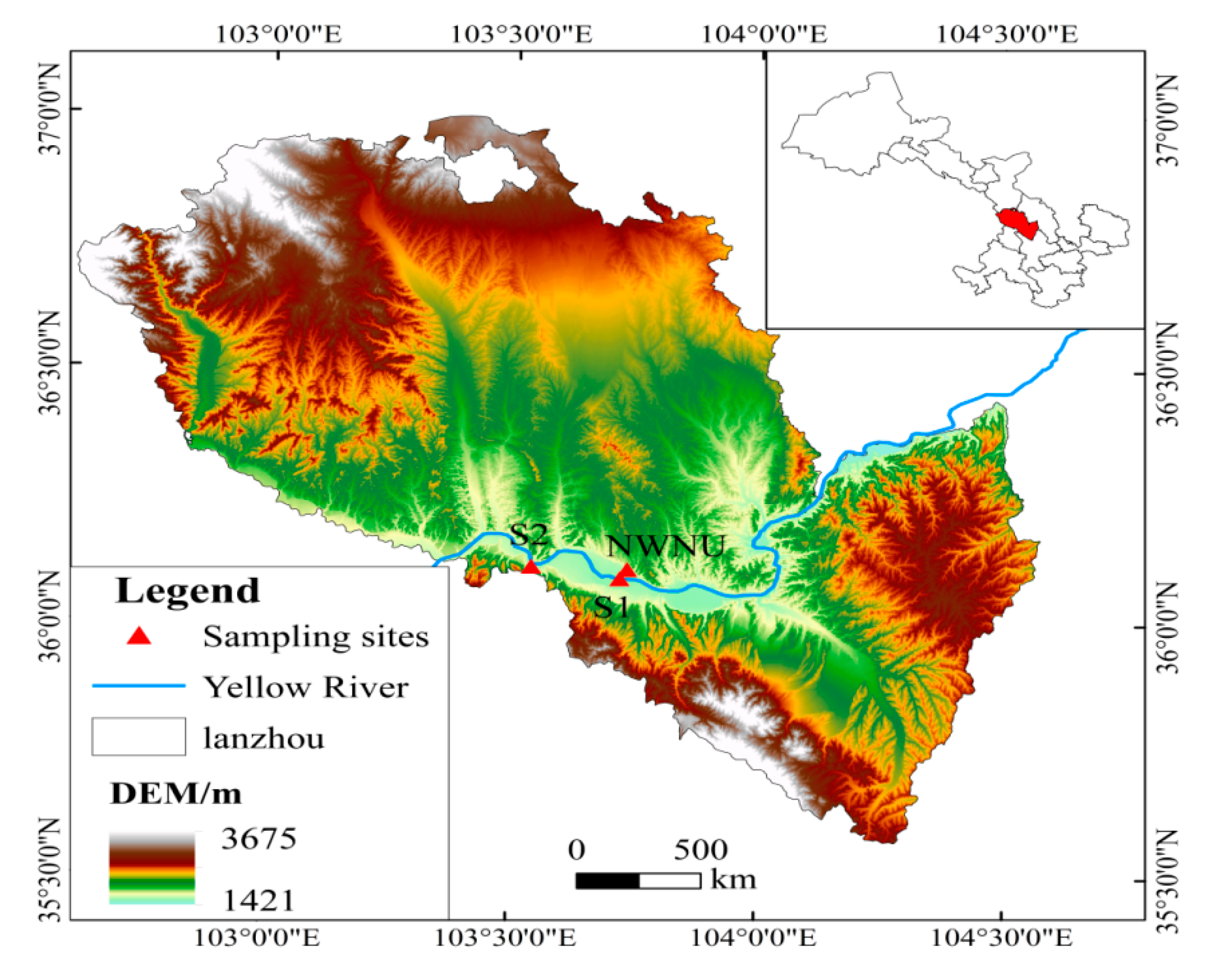
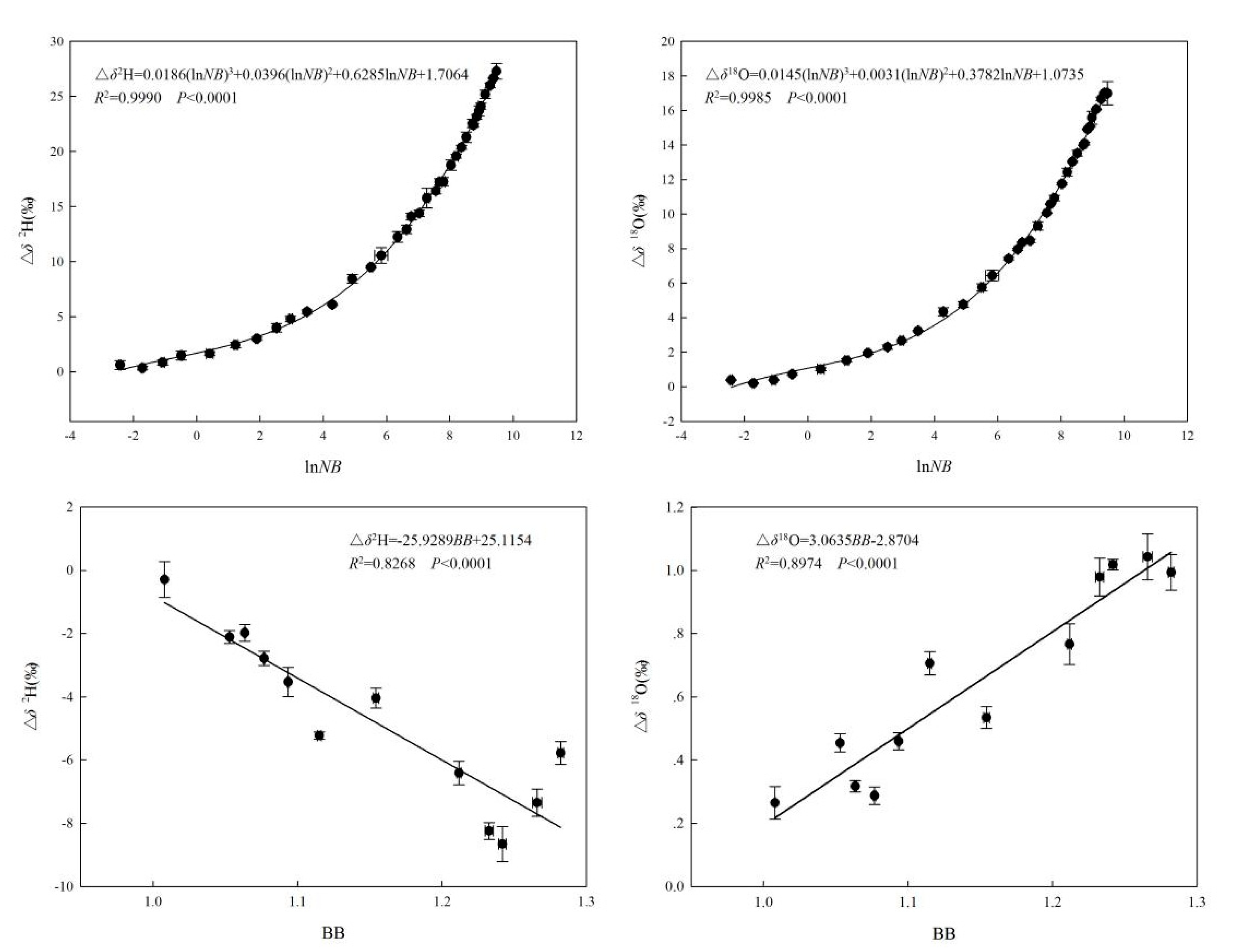
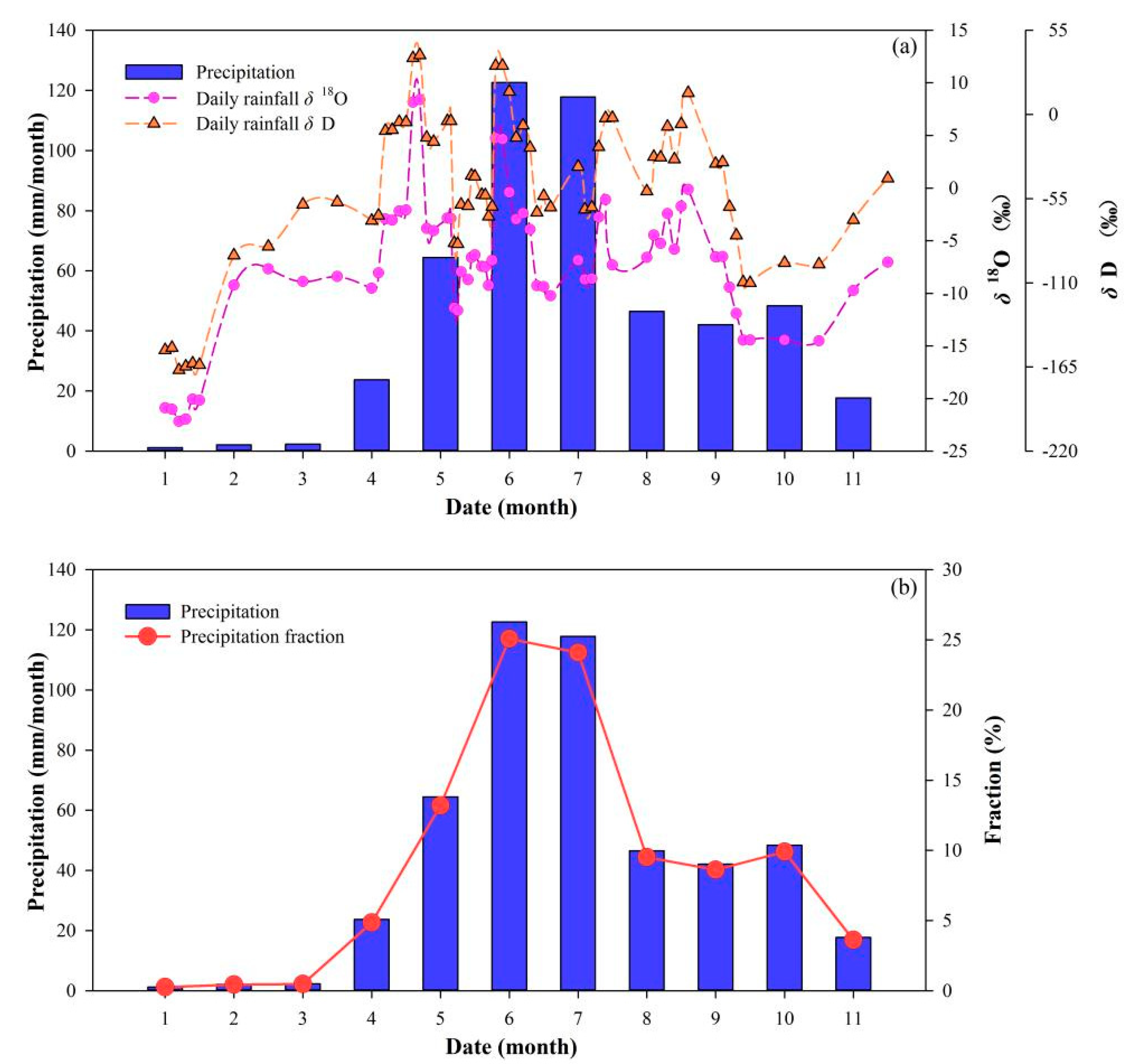
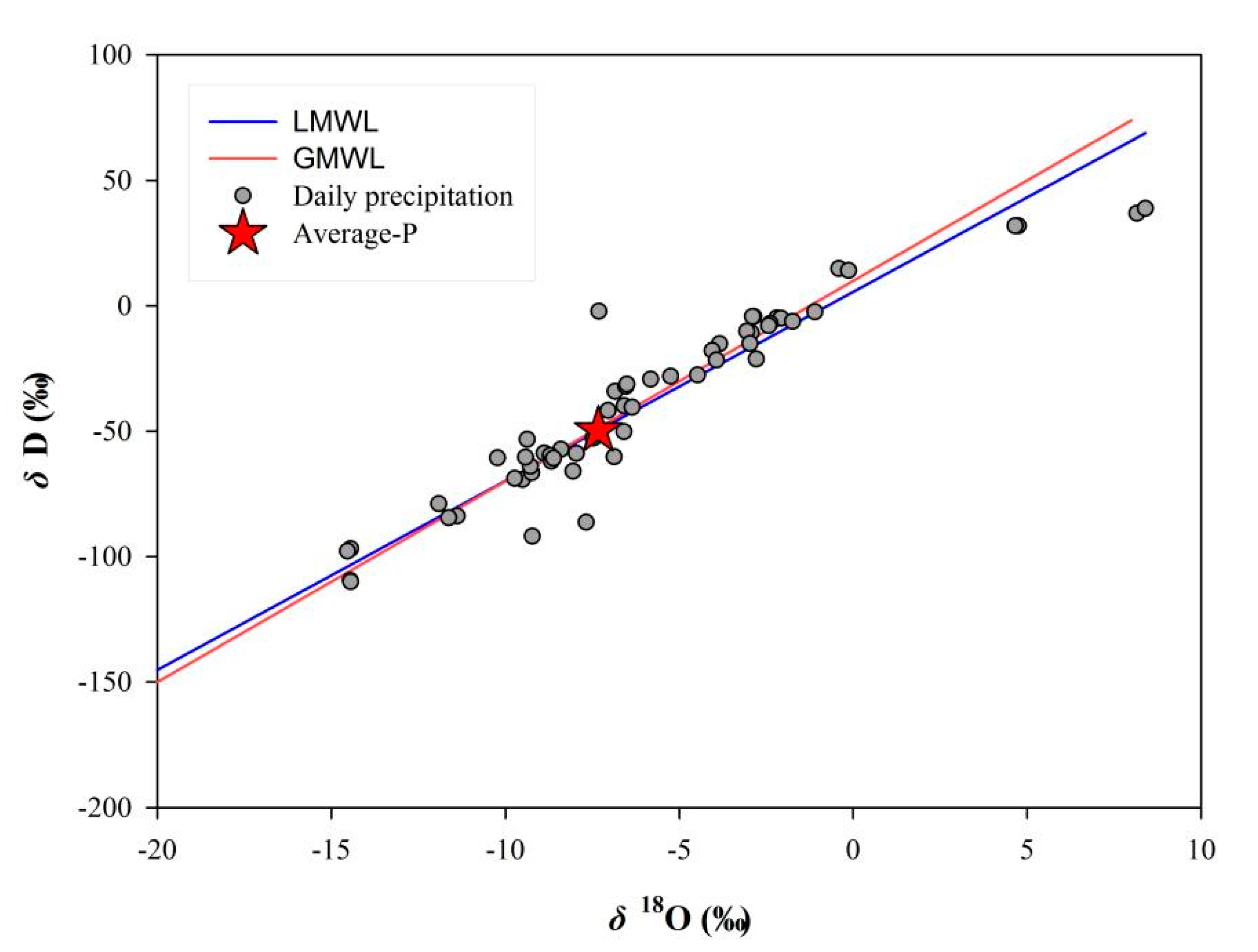
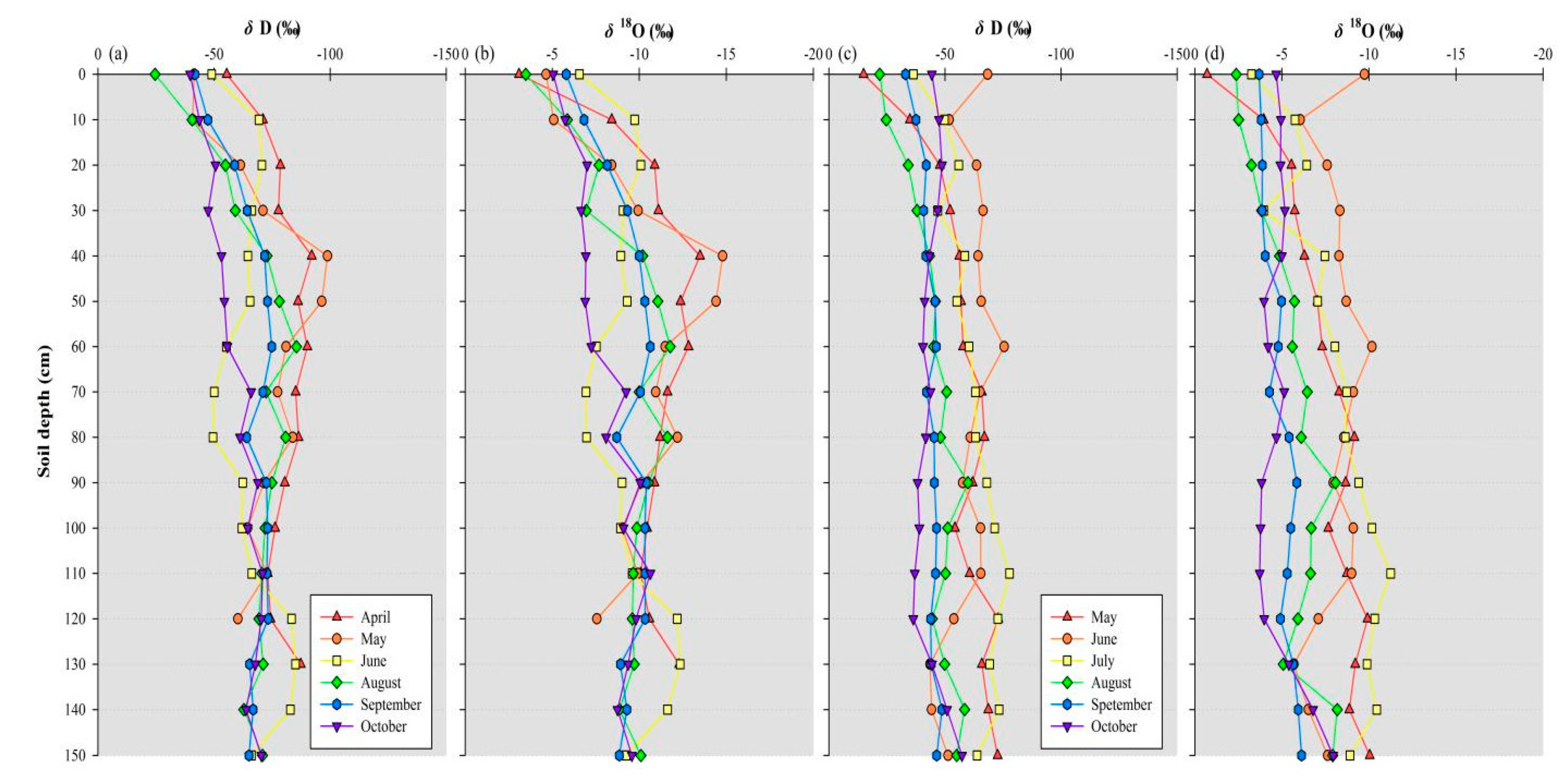
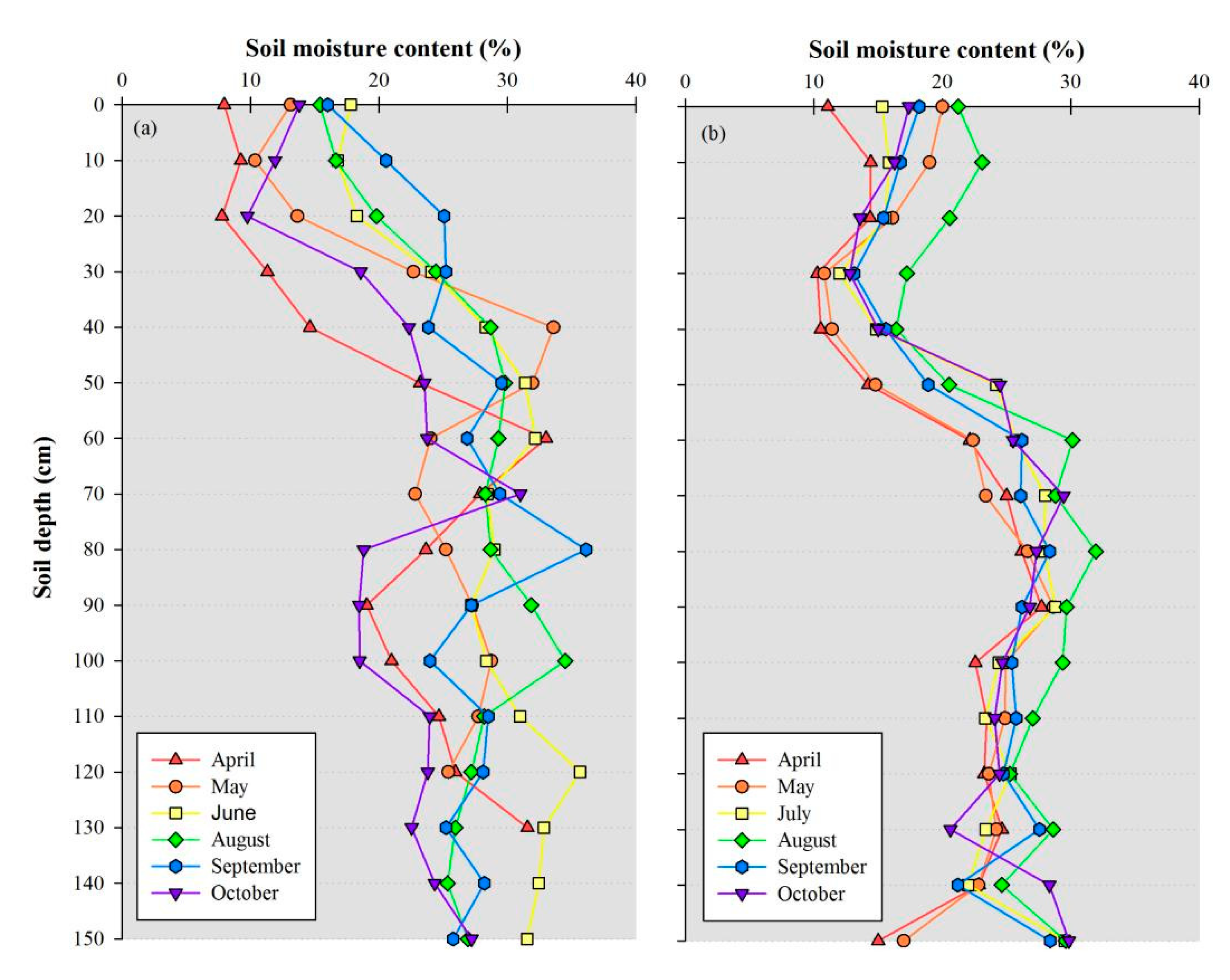
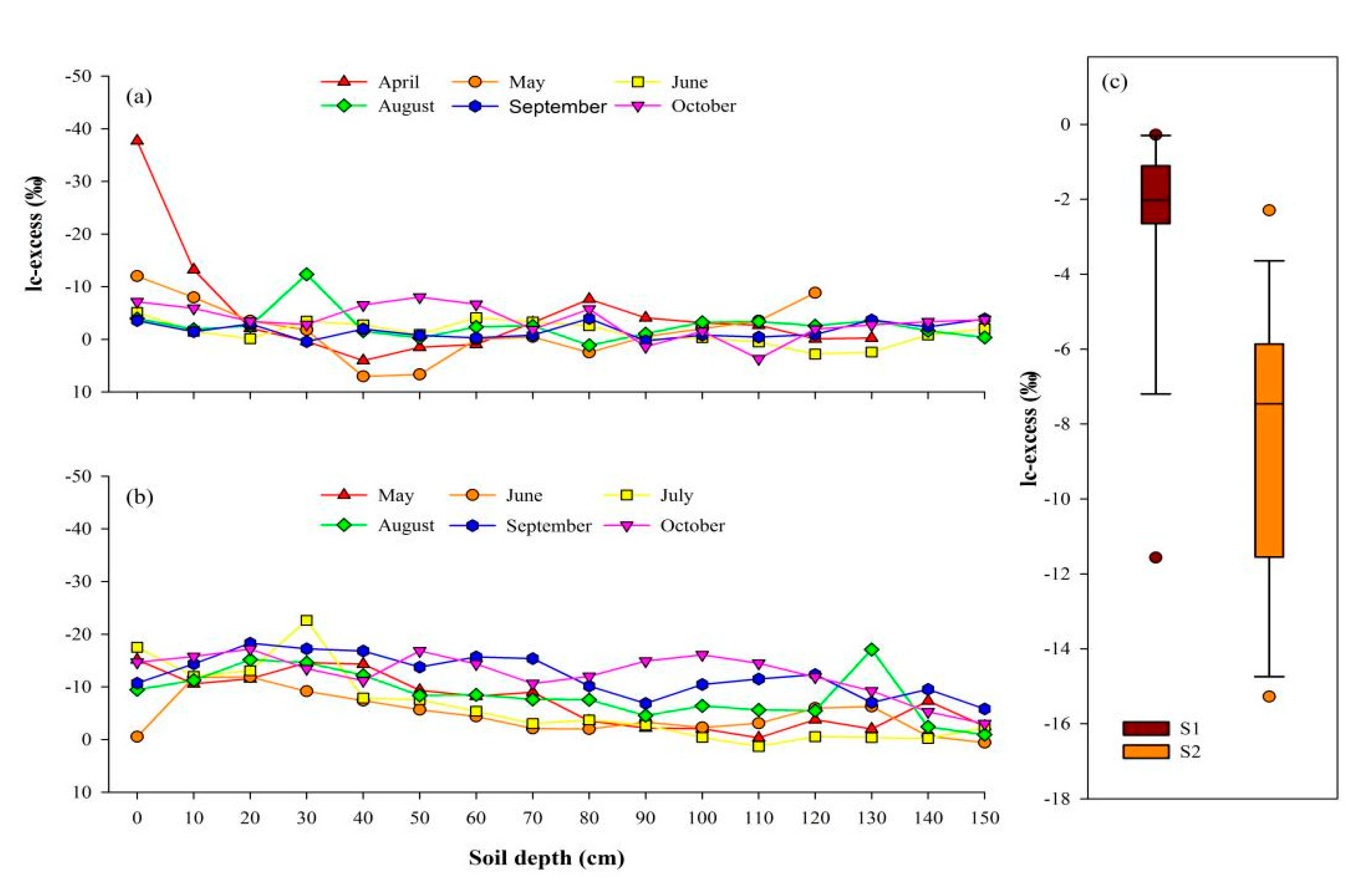

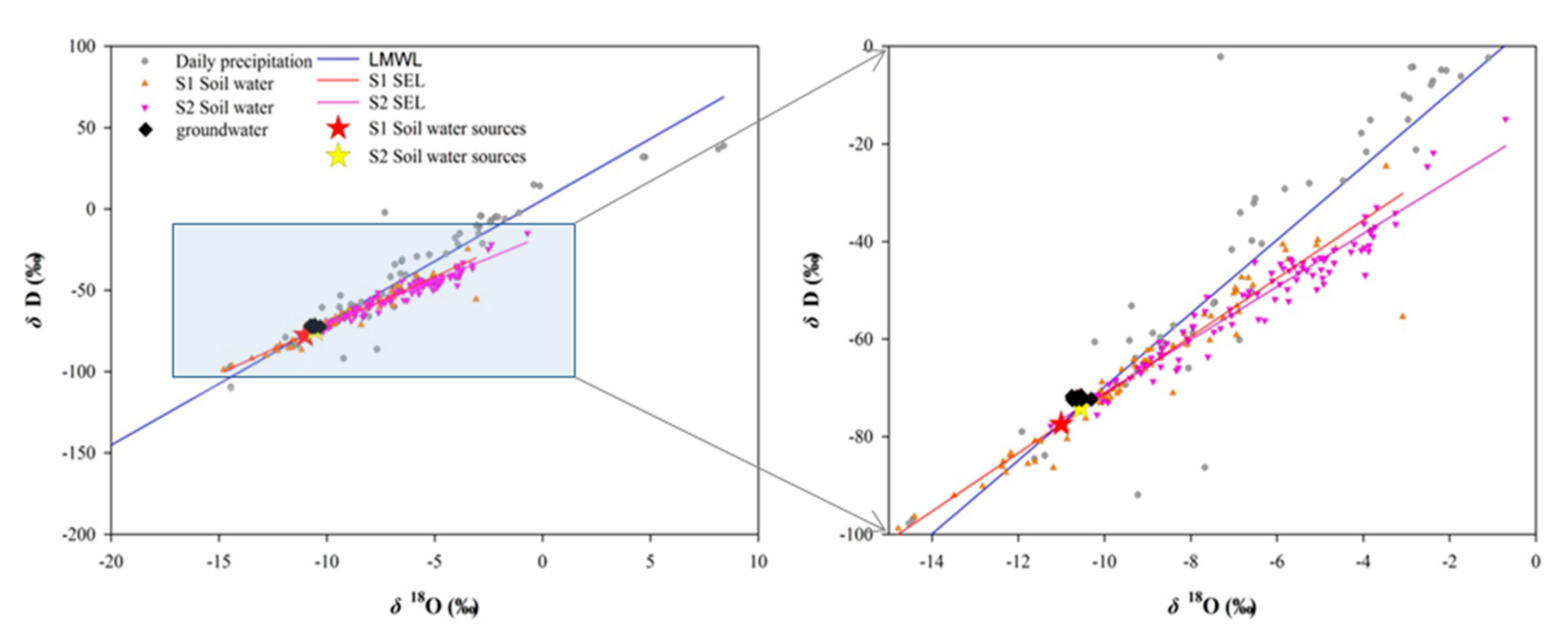
| Month | Precipitation (mm) | Fraction (%) | Weighted-δD (‰) | Weighted-δ18O (‰) | n |
|---|---|---|---|---|---|
| January | 1.2 | 0.25 | −160.73 | −21.05 | 6 |
| February | 2.1 | 0.43 | −89.14 | −8.45 | 2 |
| March | 2.3 | 0.47 | −57.98 | −8.64 | 2 |
| April | 23.7 | 4.85 | −27.55 | −4.64 | 10 |
| May | 64.5 | 13.19 | −14.47 | −3.30 | 14 |
| June | 122.6 | 25.08 | −24.77 | −8.37 | 7 |
| July | 117.8 | 24.09 | −28.93 | −5.47 | 6 |
| August | 46.5 | 9.51 | −12.74 | −3.01 | 7 |
| September | 42.1 | 8.61 | −64.39 | −10.05 | 6 |
| October | 48.4 | 9.90 | −83.34 | −14.49 | 2 |
| November | 17.7 | 3.62 | −55.27 | −8.39 | 2 |
Publisher’s Note: MDPI stays neutral with regard to jurisdictional claims in published maps and institutional affiliations. |
© 2021 by the authors. Licensee MDPI, Basel, Switzerland. This article is an open access article distributed under the terms and conditions of the Creative Commons Attribution (CC BY) license (https://creativecommons.org/licenses/by/4.0/).
Share and Cite
Wang, J.; Zhang, M.; Argiriou, A.A.; Wang, S.; Qu, D.; Zhang, Y.; Su, P. Recharge and Infiltration Mechanisms of Soil Water in the Floodplain Revealed by Water-Stable Isotopes in the Upper Yellow River. Sustainability 2021, 13, 9369. https://doi.org/10.3390/su13169369
Wang J, Zhang M, Argiriou AA, Wang S, Qu D, Zhang Y, Su P. Recharge and Infiltration Mechanisms of Soil Water in the Floodplain Revealed by Water-Stable Isotopes in the Upper Yellow River. Sustainability. 2021; 13(16):9369. https://doi.org/10.3390/su13169369
Chicago/Turabian StyleWang, Jiaxin, Mingjun Zhang, Athanassios A. Argiriou, Shengjie Wang, Deye Qu, Yu Zhang, and Pengyan Su. 2021. "Recharge and Infiltration Mechanisms of Soil Water in the Floodplain Revealed by Water-Stable Isotopes in the Upper Yellow River" Sustainability 13, no. 16: 9369. https://doi.org/10.3390/su13169369
APA StyleWang, J., Zhang, M., Argiriou, A. A., Wang, S., Qu, D., Zhang, Y., & Su, P. (2021). Recharge and Infiltration Mechanisms of Soil Water in the Floodplain Revealed by Water-Stable Isotopes in the Upper Yellow River. Sustainability, 13(16), 9369. https://doi.org/10.3390/su13169369









